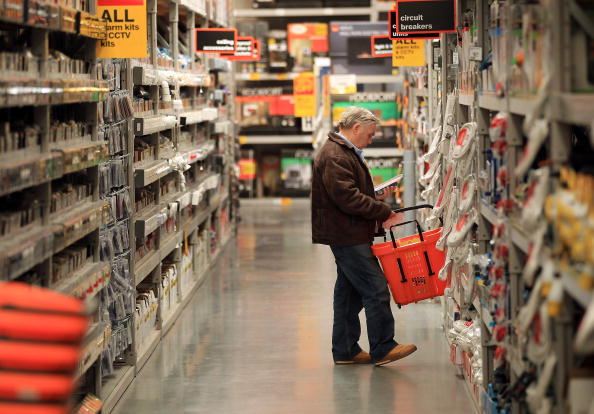Home improvement plans? Expect delays, shortages and higher prices
If you found yourself housebound during the pandemic and staring at chipped kitchen cabinets and a yellow fridge left over from the 80s, you probably realized it was time to remodel.
So you borrowed money, called a contractor and scheduled a date to start the work.
Congratulations on your project. Now comes the bad news: shortages, delays and higher prices for building materials and big-ticket home goods.
Nearly 94% of builders report at least some serious shortages of appliances, says Robert Dietz, the chief economist for the National Association of Home Builders.
“The demand for remodeling, the demand for single-family homes remains strong,” in a hot housing market, he adds.

A seller’s market: The housing market is a tale of two Americas and first-time buyers are struggling
Your credit score: Buying a home? Tips to improve your credit score
Low interest rates are making financing a home easier and boosting demand for houses in a market where the cost of most materials is rising.
Adding to that, supply-chain disruptions, manufacturing delays and labor shortages caused by the pandemic have led to the shortfalls and much longer waiting times for building materials.
All this means that the remodeling industry is having trouble delivering the final product.
5 renovations that don’t add resale value to your home
If you want to get real with your real estate, here are 5 home renovations that don’t add resale value.
Buzz60

Contractors surveyed by the NAHB said they often ran into serious, or at least some, shortages when they tried ordering material or goods. Ninety-four percent of people surveyed, for example, said they found appliances were in short supply: 90% said plywood was harder to come by; and 75% said vinyl siding was more difficult to acquire.
As for prices, softwood lumber – used for framing a house or building a deck – was up 121% in April from a year earlier, while the cost of marble was up by 6.5% in the same time period.
“I’ve heard refrigerators and microwaves are sitting in container ships off the port of Los Angeles that needed to be unloaded and then delivered,” Dietz says.
Disruptions in the production of components used in household goods, like resins, are also playing a role, he says: “Resin production was interrupted with the winter storm that affected the Texas area. And that’s having follow-on effects … for example, outdoor furniture cushions, which are now in short supply.”
In recent months, overall costs for construction material in residential home have risen 12% compared with last year, according to the NAHB.
“Unfortunately, what we’re hearing from the manufacturers, what builders are telling me is our expectation is these kinds of delays and higher costs are going to persist into 2022,” Dietz says.
Rising softwood lumber prices over the past 12 months have added $35,872 to the price of an average new single-family home, and $12,966 to the market value of an average new multifamily home, according to the NAHB.

Some remodeling contractors with larger warehouse spaces have been able to order and stockpile materials while their construction projects were on hold due to the pandemic. They’ve also been acquiring and storing materials in anticipation of a coming shortage.
But space is not a luxury most contractors have, said Mike Bellaman, CEO of Associated Builders and Contractors, a national construction industry trade association representing more than 21,000 members.
“Ninety-nine percent of construction companies are small companies that may not have the ability to do that and are really feeling the crunch,” he said.
In the past, suppliers would often be willing to hold on to materials for a week or two before making deliveries. Now, contractors are being told that they themselves are out of storage space.
“As soon as materials come in, they need to deliver them to us, whether that’s to a project site or to our warehouse,” said Dennis Gehman, owner of Gehman Design Remodeling in Harleysville, Pennsylvania.
What homeowners can expect in the midst of this massive home renovation cycle is higher bids that may be well above their budget, says Anirban Basu, the chief economist at ABC.
Basu says there’s a combination of factors at work, from input shortages and price escalations to the lack of available skilled construction workers such as electricians, plumbers, pipefitters, glazers and roofers.
“That will drive up costs for homeowners and with everyone scrambling for these contractors, what that translates into is lengthy delays in project delivery,” he says.

One of the things homeowners can do when they interview potential contractors is to check the contractor’s ability to store materials, says Gehman, who serves as the president of the National Association of Remodeling Industry.
Those with large warehouses would be capable to ordering and storing materials in advance and customers would likely face less delays.
“For a contractor who is doing their job well, it’s not only the craftsmanship or the trade skills, “ Gehman says. “But they need to have the business acumen and service to be aware that people are living there in the home, and to have a kitchen or a bathroom space that’s torn apart and just sitting there, that would not bode well, if was happening to them.”
Swapna Venugopal Ramaswamy is the Housing and Economy reporter for USA TODAY. Follow her on Twitter @SwapnaVenugopal
Published
Updated







